- Clone
- CXCR3-173 (See other available formats)
- Regulatory Status
- RUO
- Other Names
- CXCR3, G protein-coupled receptor 9 (GPR9), CKR-L2, IP10 receptor (IP10-R), Mig receptor (Mig-R )
- Isotype
- Armenian Hamster IgG
- Ave. Rating
- Submit a Review
- Product Citations
- publications
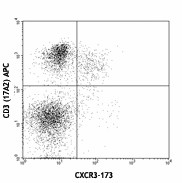
-

C57BL/6 splenocytes stained with purified CXCR3-173, followed by anti-Armenian hamster IgG FITC and anti-mouse CD3 (17A2) APC
Select size of product is eligible for a 40% discount! Promotion valid until December 31, 2024. Exclusions apply. To view full promotion terms and conditions or to contact your local BioLegend representative to receive a quote, visit our webpage.
CD183, also known as CXCR3, is a member of the C-X-C chemokine family, characterized by a pair of cysteine residues separated by a single amino acid. CXCR3 is a 38 kD seven pass transmembrane receptor coupled to G-protein. It mediates Ca2+ mobilization and chemotaxis in response to C-X-C chemokines, such as IP10 (CXCL10), MIG (CXCL9), I-TAC (CXCL11) and PF4 (CXCL4). CXCR3 is expressed primarily on activiated T lymphocytes, NK cells, and some epithelial cells and endothelial cells. It is not expressed on B cells, monocytes, or granulocytes.
Product DetailsProduct Details
- Verified Reactivity
- Mouse
- Antibody Type
- Monoclonal
- Host Species
- Armenian Hamster
- Immunogen
- Mouse N-terminus of CXCR3
- Formulation
- 0.2 µm filtered in phosphate-buffered solution, pH 7.2, containing no preservative.
- Endotoxin Level
- Less than 0.01 EU/µg of the protein (< 0.001 ng/µg of the protein) as determined by the LAL test.
- Preparation
- The Ultra-LEAF™ (Low Endotoxin, Azide-Free) antibody was purified by affinity chromatography.
- Concentration
- The antibody is bottled at the concentration indicated on the vial, typically between 2 mg/mL and 3 mg/mL. Older lots may have also been bottled at 1 mg/mL. To obtain lot-specific concentration and expiration, please enter the lot number in our Certificate of Analysis online tool.
- Storage & Handling
- The antibody solution should be stored undiluted between 2°C and 8°C. This Ultra-LEAF™ solution contains no preservative; handle under aseptic conditions.
- Application
-
FC - Quality tested
Block - Reported in the literature, not verified in house - Recommended Usage
-
Each lot of this antibody is quality control tested by immunofluorescent staining with flow cytometric analysis. For flow cytometric staining, the suggested use of this reagent is ≤0.25 µg per million cells in 100 µl volume or 100 µl of whole blood. It is recommended that the reagent be titrated for optimal performance for each application.
- Application Notes
-
Clone CXCR3-173 does not work for Western blotting.7 For in vivo studies or highly sensitive assays, we recommend Ultra-LEAF™ purified antibody (Cat. No. 126526) with endotoxin < 0.01 EU/µg, Azide-Free, 0.2 µm filtered.
-
Application References
(PubMed link indicates BioLegend citation) -
- Krug A, et al. 2002. J. Immunol. 169:6079.
- McAleer JP, et al. 2009. J. Immunol. 182:5322. PubMed
- Sharma R. 2009. J. Immunol. 183:3212. (FC) PubMed
- Barbi J, et al. 2009. FASEB J. 23:3990. PubMed
- Kimpfler S, et al. 2009. J. Immunol. 183:6330. PubMed
- Dürr C, et al. 2010. Cancer Res. 70:10170. (Block) PubMed
- Uppaluri R, et al. 2008. Transplantation 86:137.
- Product Citations
-
- RRID
-
AB_11147756 (BioLegend Cat. No. 126538)
AB_11147756 (BioLegend Cat. No. 126547)
AB_11147756 (BioLegend Cat. No. 126548)
AB_11147756 (BioLegend Cat. No. 126554)
AB_11147756 (BioLegend Cat. No. 126526)
AB_11147756 (BioLegend Cat. No. 126537)
Antigen Details
- Distribution
-
T cells, plasmacytoid dendritic cells, GM-CSF activated CD34+ hematopoietic progenitors
- Function
- Essential in T cell recruitment to sites of inflammation
- Cell Type
- Dendritic cells, Hematopoietic stem and progenitors, T cells
- Biology Area
- Immunology, Innate Immunity
- Molecular Family
- CD Molecules, Cytokine/Chemokine Receptors, GPCR
- Gene ID
- 12766 View all products for this Gene ID
- Specificity (DOES NOT SHOW ON TDS):
- CD183
- Specificity Alt (DOES NOT SHOW ON TDS):
- CD183
- App Abbreviation (DOES NOT SHOW ON TDS):
- FC,Block
- UniProt
- View information about CD183 on UniProt.org
Related FAQs
- Do you guarantee that your antibodies are totally pathogen free?
-
BioLegend does not test for pathogens in-house aside from the GoInVivo™ product line. However, upon request, this can be tested on a custom basis with an outside, independent laboratory.
- Does BioLegend test each Ultra-LEAF™ antibody by functional assay?
-
No, BioLegend does not test Ultra-LEAF™ antibodies by functional assays unless otherwise indicated. Due to the possible complexities and variations of uses of biofunctional antibodies in different assays and because of the large product portfolio, BioLegend does not currently perform functional assays as a routine QC for the antibodies. However, we do provide references in which the antibodies were used for functional assays and we do perform QC to verify the specificity and quality of the antibody based on our strict specification criteria.
- Does BioLegend test each Ultra-LEAF™ antibody for potential pathogens?
-
No, BioLegend does not test for pathogens in-house unless otherwise indicated. However, we can recommend an outside vendor to perform this testing as needed.
- Have you tested this Ultra-LEAF™ antibody for in vivo or in vitro applications?
-
We don't test our antibodies for in vivo or in vitro applications unless otherwise indicated. Depending on the product, the TDS may describe literature supporting usage of a particular product for bioassay. It may be best to further consult the literature to find clone specific information.
Other Formats
View All CD183 Reagents Request Custom Conjugation| Description | Clone | Applications |
|---|---|---|
| Brilliant Violet 510™ anti-mouse CD183 (CXCR3) | CXCR3-173 | FC |
| PE anti-mouse CD183 (CXCR3) | CXCR3-173 | FC |
| Biotin anti-mouse CD183 (CXCR3) | CXCR3-173 | FC |
| APC/Fire™ 750 anti-mouse CD183 (CXCR3) | CXCR3-173 | FC |
| Purified anti-mouse CD183 (CXCR3) | CXCR3-173 | FC,Block |
| APC anti-mouse CD183 (CXCR3) | CXCR3-173 | FC |
| PerCP/Cyanine5.5 anti-mouse CD183 (CXCR3) | CXCR3-173 | FC |
| PE/Cyanine7 anti-mouse CD183 (CXCR3) | CXCR3-173 | FC |
| Brilliant Violet 421™ anti-mouse CD183 (CXCR3) | CXCR3-173 | FC |
| Brilliant Violet 605™ anti-mouse CD183 (CXCR3) | CXCR3-173 | FC |
| Ultra-LEAF™ Purified anti-mouse CD183 (CXCR3) | CXCR3-173 | FC,Block |
| Brilliant Violet 650™ anti-mouse CD183 (CXCR3) | CXCR3-173 | FC |
| PE/Dazzle™ 594 anti-mouse CD183 (CXCR3) | CXCR3-173 | FC |
| FITC anti-mouse CD183 (CXCR3) | CXCR3-173 | FC |
| Alexa Fluor® 488 anti-mouse CD183 (CXCR3) | CXCR3-173 | FC |
| TotalSeq™-C0228 anti-mouse CD183 (CXCR3) | CXCR3-173 | PG |
| TotalSeq™-B0228 anti-mouse CD183 (CXCR3) | CXCR3-173 | PG |
| APC/Cyanine7 anti-mouse CD183 (CXCR3) | CXCR3-173 | FC |
Customers Also Purchased
Compare Data Across All Formats
This data display is provided for general comparisons between formats.
Your actual data may vary due to variations in samples, target cells, instruments and their settings, staining conditions, and other factors.
If you need assistance with selecting the best format contact our expert technical support team.
-
Brilliant Violet 510™ anti-mouse CD183 (CXCR3)
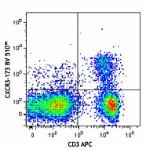
C57BL/6 mouse splenocytes were stained with CD3 APC and CXCR... 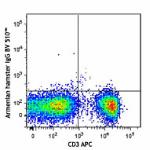
-
PE anti-mouse CD183 (CXCR3)
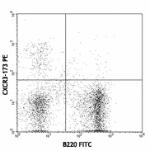
C57BL/6 splenocytes stained with CXCR3-173 PE and B220 FITC -
Biotin anti-mouse CD183 (CXCR3)
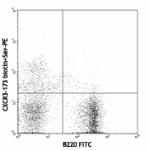
C57BL/6 splenocytes stained with B220 (RA3-6B2) FITC and CXC... -
APC/Fire™ 750 anti-mouse CD183 (CXCR3)
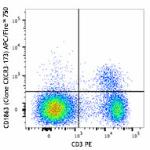
C57BL/6 mouse splenocytes were stained with CD3 PE and CXCR3... 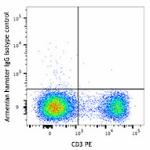
-
Purified anti-mouse CD183 (CXCR3)
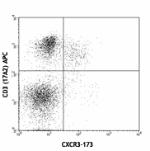
C57BL/6 splenocytes stained with purified CXCR3-173, followe... -
APC anti-mouse CD183 (CXCR3)
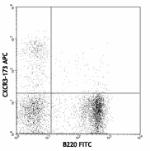
C57BL/6 splenocytes stained with B220 (RA3-6B2) FITC and CXC... -
PerCP/Cyanine5.5 anti-mouse CD183 (CXCR3)

C57BL/6 splenocytes were stained with CD3e APC and CD183 Per... -
PE/Cyanine7 anti-mouse CD183 (CXCR3)
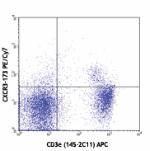
C57BL/6 splenocytes stained with CXCR3-173 PE/Cyanine7 and C... 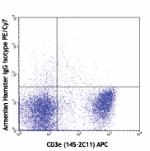
C57BL/6 splenocytes stained with Armenian Hamster IgG isotyp... -
Brilliant Violet 421™ anti-mouse CD183 (CXCR3)
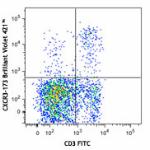
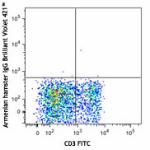
-
Brilliant Violet 605™ anti-mouse CD183 (CXCR3)
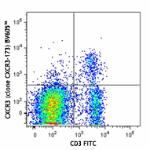
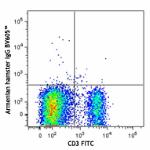
-
Ultra-LEAF™ Purified anti-mouse CD183 (CXCR3)

C57BL/6 splenocytes stained with purified CXCR3-173, followe... -
Brilliant Violet 650™ anti-mouse CD183 (CXCR3)
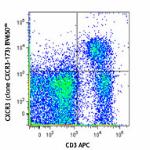
C57BL/6 mouse splenocytes were stained with CD3 APC and CXCR... 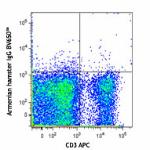
-
PE/Dazzle™ 594 anti-mouse CD183 (CXCR3)

C57BL/6 mouse splenocytes were stained with CD3 APC and CXCR... 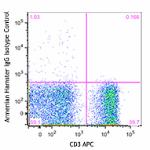
-
FITC anti-mouse CD183 (CXCR3)
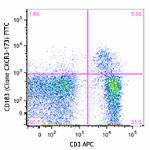
C57BL/6 mouse splenocytes were stained with CD3 APC and CXCR... 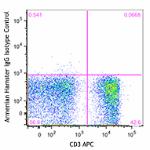
-
Alexa Fluor® 488 anti-mouse CD183 (CXCR3)
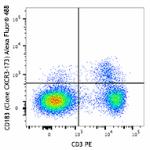
C57BL/6 mouse splenocytes were stained with CD3 PE and CXCR3... 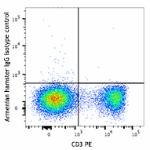
-
TotalSeq™-C0228 anti-mouse CD183 (CXCR3)
-
TotalSeq™-B0228 anti-mouse CD183 (CXCR3)
-
APC/Cyanine7 anti-mouse CD183 (CXCR3)

C57BL/6 mouse splenocytes were stained with anti-mouse CD3 F...
 Login / Register
Login / Register 







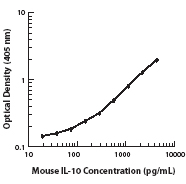




Follow Us